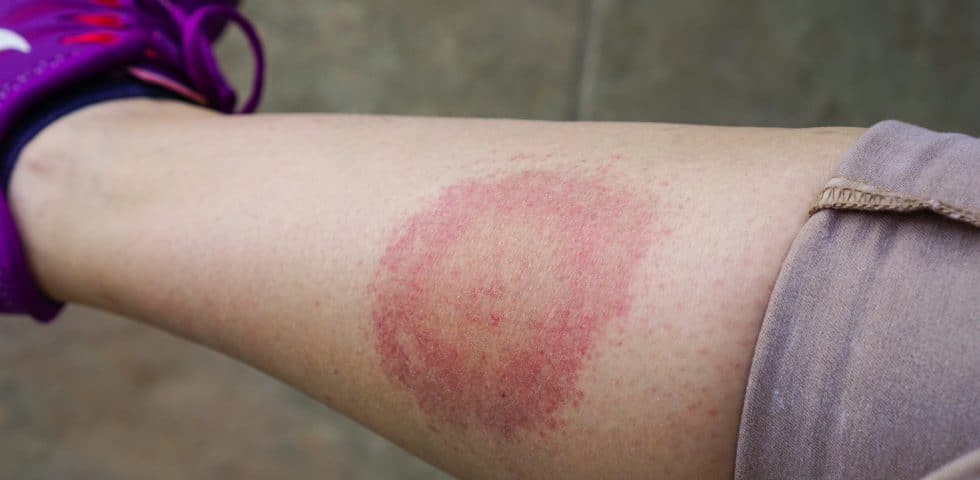Lyme disease is a tick-borne infection, that is caused by bacteria. Left untreated, it can cause a range of chronic symptoms, and have a very detrimental effect on your feeling of health and wellbeing.
If you have any of the symptoms we’re about to discuss, you’ve had a tick bite, and you live in an area where Lyme disease occurs (you can learn more on the CDC website), it’s really important that you seek medical attention. Here are the key things to know to start restoring your health.
Want to book an appointment with Dr. Ridinger? Use our contact form.
Early Symptoms of Lyme Disease
The first sign of Lyme disease is usually a noticeable rash in the shape of a bulls-eye. According to the CDC, this occurs in about 70-80% of cases, and spreads from the site of the tick bite. It takes between three and 30 days to appear, and may expand gradually to cover an area of up to 12 inches.
However, the absence of a rash doesn’t necessarily rule out Lyme disease. Many patients also experience fevers, chills, headaches, fatigue, muscle aches, joint aches, and swollen lymph nodes.
Advanced Symptoms of Lyme Disease
As Lyme disease progresses, it can significantly affect your health and wellbeing. You may notice joint swelling, or arthritis, that appears without a simple explanation. You could experience severe and ongoing headaches and neck pain. It’s common to experience intermittent pains in your muscles and tendons, as well as heart palpitations, or episodes of dizziness or shortness of breath.
Some cases may also cause inflammation of the brain and spinal cord, as well as nerve issues. This can result in very unpleasant symptoms like shooting pains, numbness, or tingling in the fingers and toes. It may also cause facial palsy, which is where one or both sides of the face start to droop.
Chronic Symptoms of Lyme Disease
Over time, the symptoms patients experience can become increasingly severe. This can include extreme fatigue, joint pain, muscle pain, nerve pain, mental fog, depression, anxiety, and many other symptoms. It can affect your sleep, hormone levels, gut health, immune system, and more.
Lyme disease is also commonly misdiagnosed as other conditions. Commonly, this includes things like fibromyalgia, chronic fatigue syndrome, rheumatoid arthritis, lupus, and psychiatric disorders. It can be very difficult to diagnose – for example, it’s possible to have Lyme disease without getting a positive result on a Lyme disease test. Not everyone gets the classic bulls-eye rash. This disease is very complex to treat, because it can tie a range of seemingly unrelated symptoms together.
Is Lyme Disease Real?
One of the most commonly asked questions about Lyme disease is whether it’s real. According to the CDC, it’s the most commonly-reported tick-borne infection in the United States. In fact, the organization estimates that more than 300,000 Americans are diagnosed and treated each year.
A lot of research is currently underway to improve the accuracy of early testing and diagnosis. At the moment, most doctors use a two-step testing process, which are done using a blood sample. It’s designed to detect antibodies the body makes to fight infection, however, they can take several weeks to develop (meaning you may return a negative test in the early stages) and they can stay in the blood for a long time after the infection is gone (meaning the results may be out of date).
Is Lyme Disease Curable?
Searching for answers to Lyme disease can feel like going on a wild goose chase. If you have a range of symptoms that fit the description above, you should see a doctor who specializes in diagnosis and treatment of Lyme disease. When you’re choosing a provider, it’s important to seek out a holistic and integrative approach to treatment to ensure you get the best possible treatment plan.
The International Lyme and Associated Diseases Society (commonly called ILADS), recommends long-term treatments that takes the needs of each individual into account. This includes evidence-based treatments like diet, supplements, bioidentical hormones, herbal therapies, and even antibiotics. It’s the first step to healing your body and starting the journey back towards well-being.
Looking for a holistic medicine practitioner in Virginia? Contact us today.


